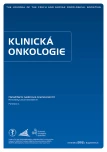Surgical Prevention of Breast Carcinoma in Patients with Hereditary Risk
Authors:
L. Dražan 1; J. Veselý 1; P. Hýža 1; T. Kubek 1; L. Foretová 2; O. Coufal 2
Authors‘ workplace:
Klinika plastické a estetické chirurgie, Fakultní nemocnice u sv. Anny v Brně
1; Masarykův onkologický ústav, Brno
2
Published in:
Klin Onkol 2012; 25(Supplementum): 78-83
Overview
Background:
Women with BRCA1 gene mutation have 85% risk of breast cancer; the risk for BRCA2 carriers is 45%. The aim of the study was to verify if prophylactic mastectomy with immediate breast reconstruction can prevent breast cancer in BRCA positive patients.
Material:
There were 100 BRCA positive women in which prophylactic mastectomy with immediate reconstruction, 75 dieps, 25 with implants, performed in period 2000–2011. Group A was composed of healthy, non-affected 41 patients, group B of 59 patients in remission after breast cancer treatment. These groups were compared to group C that consisted of 219 healthy carriers of BRCA1/2, non-operated, from registry of genetic department of the Masaryk Memorial Cancer in Brno, from 2000–2011.
Method:
Follow-up for oncology status was done in September 2011 for all 3 groups.
Results:
Average follow-up of 21 months revealed that in group A there was no breast cancer, in group B 4 patients died and 2 had treatment for metastases. In group C, there were 16 new cases of breast cancer.
Conclusion:
Bilateral prophylactic mastectomy with immediate reconstruction can be an effective way in breast cancer prevention in healthy carriers of BRCA1/2 mutation. In BRCA positive patients treated for breast cancer, the effect of prophylactic mastectomy is unclear. Their survival is more influenced by their previous disease than by a new tumor in the breast.
Key words:
prophylactic mastectomy – BRCA – immediate breast reconstruction
The study was supported by:
grant of Internal Grant agency of the Czech Ministry of health No. Ns10401-3. Genetical testing was supported by the EU Operational Program OP VaVpI – RECaMO and by development project of the Government of the Czech Republic under contract No.CZ.1.05/2.1.00/03.0101.
The authors declare they have no potential conflicts of interest concerning drugs, products, or services used in the study.
The Editorial board declares that the manuscript met the ICMJE “uniform requirements” for biomedical papers.
Submitted:
18. 4. 2012
Accepted:
21. 5. 2012
Sources
1. Dražan L, Měšťák J. Rekonstrukce prsu po mastektomii. Praha: Grada Publishing 2006. 103–105.
2. Allen RJ, Treece P. Deep inferior epigastric perforator flap for breast reconstruction. Ann Plast Surg 1994; 32(1): 32–40.
3. Blondeel PN, Vadenstraeten GG, Monstrey SJ et al. The donor site morbidity of the free DIEP flaps and free TRAM flaps for breast reconstruction. Br J Plast Surg 1997; 50(5): 322–330.
4. Wooster R, Bignell G, Lancester J et al. Identification of the breast cancer susceptibilitiy gene BRCA2. Nature 1996; 379(6559): 749–775.
5. Easton DF, Ford D, Bishop DT. Breast and ovarian cancer incidence in BRCA1-mutation carriers. The Breast Cancer Linkage Consortium. Am J Hum Genet 1995; 56(1): 256–271.
6. Ford D, Bishop DT, Narod SA et al. Risk of cancer in BRCA1-mutation carriers. The Breast Cancer Linkage Consortium. Lancet 1994; 343(8899): 692–695.
7. Ford D, Easton DF. The genetics of breast and ovarian cancer. Br J Cancer 1995; 72(4): 805–812.
8. Easton DF, Bishop DT, Ford D et al. Genetic linkage analysis in familial breast and ovarial cancer: results from 214 families. The Breast Cancer Linkage Consortium. Am J Hum Genet 1993; 52(4): 678–701.
9. Dražan L. Profylaktická mastektomie s rekonstrukcí. Příručka pro pacientky. Akademické nakladatelství CERM, 2010. 1–32.
10. Bonde TCH, Christensen DE, Elberg JJ. Ten years experience of free flaps for breast reconstruction in a Danish microsurgical centre: An Audit. Scand J Plast Reconstr Surg Hand Surg 2006; 40(1): 8–12.
11. Blondeel PN. One hundred free DIEP flap breast reconstruction: a personal experience. Br J Plast Surg 1999; 52(2): 104–111.
12. Hamdi M, Weiler-Mithoff EM, Webster MH. Deep inferior epigastric perforator flap in breast reconstruction:experience with the first 50 flaps. Plast Reconstr Surg 1999; 103(1): 86–95.
13. Gerber B, Krause A, Reimer T et al. Skin-sparing mastectomy with conservation of nipple-areola komplex and autologous is oncologically safe procedure. Ann Surg 2003; 238(1): 120–127.
14. Al-Ghazal SK, Blamey RW. Subkutaneous mastectomy with implant reconstruction: cosmetic outcome and patient satisfaction. Eur J Surg Oncol 2000; 26(2): 137–141.
15. Hartmann LC, Schaid DJ, Woods JE. Efficacy of bilateral prophylactic mastectomy in woman with a family history of breast cancer. N Engl J Med 1999; 340(2): 77–85.
16. Dražan L, Mrázek T, Dungelová E. Bilateral Breast Reconstruction After Mastectomy: Acta Chirurgiae Plasticae 1991; 33(4): 217–220.
17. Meijers-Heijboer H, van Geel B, van Putten WLJ et al. Breast cancer after prophylactic bilateral mastectomy in women with a BRCA1 or BRCA2 mutation. N Engl J Med 2001; 345(3): 159–163.
18. Klijn JGM, Van Geel, Meijers-Heijboer H et al. Long-term follow-up of the Rotterdam study on prophylactic mastectomy versus surveillance in BRCA1/2 mutation carriers. J Clin Oncol 2004; 22 : 9502.
Labels
Paediatric clinical oncology Surgery Clinical oncologyArticle was published in
Clinical Oncology

2012 Issue Supplementum
Most read in this issue
- Birt-Hogg-Dubé Syndrome
- The Clinical Importance of a Genetic Analysis of Moderate-Risk Cancer Susceptibility Genes in Breast and Other Cancer Patients from the Czech Republic
- Hereditary Diffuse Gastric Cancer
- Clinical Dysmorphic Syndromes with Tumorigenesis
